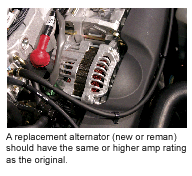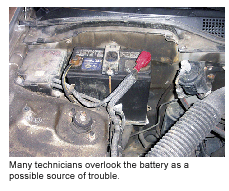What do you really need to know about diagnosing and repairing starting, charging and ignition systems? Basically two things: that electrical and ignition problems are often difficult to diagnose (especially intermittent faults), and that a lot of electrical and ignition parts are unnecessarily replaced in an attempt to repair problems that are hard to diagnose.
Throwing parts at a problem until it goes away is a very expensive way of fixing faults. The “no return” policy on installed parts of many parts stores means that once you’ve installed an electrical or ignition part on a customer’s vehicle, he owns it.
 What if the part turns out to be “defective”? In many instances, there’s nothing wrong with the part. The store will usually exchange it under warranty. But if the second part also fails to fix the fault, it’s obvious something else is at fault. So don’t be too quick to blame “defective” parts when a newly installed part doesn’t seem to work any better than the old one, or when you get a comeback. Do your diagnostic homework, then isolate the fault and identify any parts that may need to be replaced.
What if the part turns out to be “defective”? In many instances, there’s nothing wrong with the part. The store will usually exchange it under warranty. But if the second part also fails to fix the fault, it’s obvious something else is at fault. So don’t be too quick to blame “defective” parts when a newly installed part doesn’t seem to work any better than the old one, or when you get a comeback. Do your diagnostic homework, then isolate the fault and identify any parts that may need to be replaced.
SCAN TOOL DIAGNOSTICS
Some parts stores might offer customers a free “diagnosis” if their Malfunction Indicator Lamp (MIL) is on. A store employee will plug a code reader or basic scan tool into the customer’s vehicle and read out any codes that appear. The code may provide a clue as to what’s going on, but it seldom tells you which part needs to be replaced. Further diagnosis is almost always needed with a full-feature scan tool, a digital storage oscilloscope and/or other test equipment, which, oftentimes, brings these customers to your shop to get the problem solved.
One thing to keep in mind about scan tool codes is that codes are primarily for emission faults, not electrical faults. Ignition faults such as misfires certainly qualify as emission faults and will trigger the MIL lamp and set a code if the rate of misfire is high enough to cause a problem. A low battery, or an unusually low (or high) charging voltage, may set a code, but a weak battery, poor ground or bad starter probably won’t.
Even when you have a code, you’ll often have to perform additional tests to find out what’s causing the problem. A misfire code, for example, will tell you the engine is misfiring and which cylinder is the culprit – unless you have a P0300 code which indicates a random misfire that can’t be isolated to any given cylinder. But even when you have a cylinder-specific code, you still don’t know if the misfire is due to fuel, ignition or compression. The cause might be a fouled spark plug, bad plug wire or weak ignition coil. Or, it might be a dirty or dead fuel injector. It might also be a compression problem due to a burned or bent valve, a leaky head gasket or a rounded cam lobe.
And what do you do when you have a no-start/no- code condition? The problem might be no ignition, fuel or compression. Or, it might be a bad battery, starter, ignition switch or safety circuit, or anti-theft immobilizer system if the engine won’t crank.
START WITH THE BATTERY
Many driveability and starting problems that are charging, starting or ignition related may be due to low battery voltage. It’s a simple thing to check, yet many technicians overlook the battery as a possible source of trouble. Low battery voltage can also affect fuel delivery by causing the fuel pump to run slower than normal. This, in turn, causes low fuel pressure and a lean fuel condition. Under some conditions, a low battery may even prevent one or more injectors from opening normally, causing lean misfire and/or hard starting.
 Automotive lead-acid batteries must be kept at or near full charge for optimum performance and longevity. If a battery is run down or becomes fully discharged, undesirable changes start to occur on the lead plates inside the battery. The plates develop a layer of sulfate that resists recharging and reduces the battery’s ability to store power. If the battery is chronically run down or discharged, it significantly shortens battery life.
Automotive lead-acid batteries must be kept at or near full charge for optimum performance and longevity. If a battery is run down or becomes fully discharged, undesirable changes start to occur on the lead plates inside the battery. The plates develop a layer of sulfate that resists recharging and reduces the battery’s ability to store power. If the battery is chronically run down or discharged, it significantly shortens battery life.
Average battery life under the best of conditions is only about four or five years in most vehicles, and only about three years in places like Arizona and New Mexico where summer temperatures typically soar into the triple digits. Many motorists who are driving vehicles with batteries that are four, five or six years old may not realize their batteries are failing until their engine fails to start and they are stranded.
Cold weather also puts a two-fold strain on the battery by reducing its power output (up to 50 percent at 20





